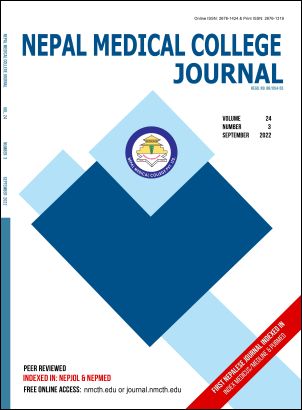Seroprevalence of COVID-19 among health workers in the Kathmandu Valley, Nepal: a longitudinal cohort study
DOI:
https://doi.org/10.3126/nmcj.v24i3.48592Keywords:
COVID-19, seroprevalence, health workers, NepalAbstract
Coronavirus Disease 2019 (COVID-19) burden, often underestimated by case-based incidence reports, can be accurately estimated by measuring the population that has developed antibodies following an infection. Here, we report the prevalence of COVID-19 antibodies among health workers in Kathmandu, Nepal. This seroepidemiology of COVID-19 was a longitudinal survey of hospital-based health workers working in 20 hospitals in the Kathmandu Valley. A total of 800 participants were chosen in December 2020 by a two-stage cluster-stratified random sampling method and administered a questionnaire eliciting COVID-19 related history. A blood sample was also obtained from the participants and tested for COVID-19 IgG antibodies using a Chemiluminescence Immunoassay (CLIA). We then used a probabilistic multilevel regression model with post-stratification to correct for test accuracy, the effect of hospital-based clustering, and to ensure representativeness. The final analytic sample included 800 participants; 522 (65.2%) of them were female, 372 (46%) were between ages 18-29, 287 (36%) were nurses. Of the total 800, 321 (40.1%) individuals tested positive for COVID-19 antibodies. Adjusted for test accuracy and health-worker population, the seroprevalence was 38.2% (95% Credible Interval (CrI) 29.26%–47.82%). Posterior predictive hospital-wise seroprevalence ranged between 38.1% (95% CrI 30.7.0%–44.1%) and 40.5% (95% CrI 34.7%–47.0%). Our study suggested that about two in five health workers in the Kathmandu Valley were seropositive against SARS-CoV-2 by December 2020; a substantial proportion of them did not have a documented infection.
Downloads
Downloads
Published
How to Cite
Issue
Section
License
Copyright (c) 2022 Nepal Medical College Journal

This work is licensed under a Creative Commons Attribution 4.0 International License.
This license enables reusers to distribute, remix, adapt, and build upon the material in any medium or format, so long as attribution is given to the creator. The license allows for commercial use.




